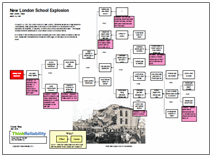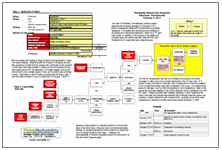A natural gas leak at a business plaza in Kansas City was reported to the Fire Department just prior to 5 pm on February 19, 2013. However, the area was not evacuated until just prior to an explosion that left 1 dead and 15 injured. The leaking gas was not shut off until 3 hours after the report.
The causes that resulted in this tragedy can be examined within a Cause Map, or visual root cause analysis. The analysis begins by determining which goals were impacted in a problem outline, which captures the what, when and where of the incident, as well as the impact to the goals. In this case, the safety goal was impacted due to the fatality and injuries. The environmental goal was impacted due to the natural gas leak and the customer service goal was impacted due to an ineffective evacuation. (How do we know it was ineffective? Because people were still present in a building that exploded due to a gas leak that was known for almost an hour, although the timing of the ordered evacuation is not known.) Additionally, the property goal was impacted due to the destruction of restaurant, which was the site of the explosion, and damage to adjoining properties. Lastly, the labor goal is impacted due to the investigation by state utility regulators, which is expected to take months of painstaking work to add detail to the causes which are already known.
Once these goals have been determined, we begin with an impacted goal and ask “Why” questions to add detail to the analysis. The safety goal was impacted due to the death and injuries. These occurred because of the explosion AND because people were in the proximity of the explosion. Had the explosion occurred after a complete evacuation, the injuries would have been substantially reduced, if not completely prevented, although the property goals would have still been impacted.
An evacuation ws not ordered by the fire department, who deferred to the utility company. The utility company was slow in determining that an evacuation was needed. There was general confusion about the responsibility for determining an evacuation. Per the city’s emergency response plan, the Incident Commander is responsible for evacuations. However, no Incident Commander was named on-scene until after the explosion, as it was determined that no incident yet existed. Because quite a bit of flexibility is generally needed in determining whether an evacuation is needed (as an evacuation itself can be dangerous), the emergency response plan is necessary somewhat confusing (in this case, contained in a 90-page document).
The explosion itself resulted from an unknown heat source within the restaurant igniting leaked natural gas. The natural gas was leaking as a result of being struck by a boring machine being used to install fiber-optic cable in the area. It was later determined that the contractor did not have the necessary permit for the work, though it’s not clear if that led to confusion on the location of the gas lines, or if they were mislabeled, or if it’s just that it’s really difficult to see lines when digging deep trenches using a boring machine.
The extent and probability of an explosion is related to the volume of gas released during a leak. Had the gas been turned off earlier, the explosion might have been avoided, or lessened, reducing the impacts to all the goals. The gas was not turned off before the explosion, and after the explosion continuing fires made the shut-off locations difficult to reach. it’s not clear why the gas wasn’t turned off immediately, though the choice to do so does result in other impacts, such as the loss of gas to other customers. In cases where the true extent of the issue is not known, it is difficult to make these decisions and limit potential effects.
Because one of the issues was not knowing the extent of the leak, it has been suggested that all fire department trucks be equipped with natural gas sniffers. Additionally, an update to the city’s evacuation protocol has been called for that would, among other changes, give authority to the first arriving public safety official to order an evacuation, resulting some of the confusion that led to the tragedy in Kansas City.
As this example shows, it’s not only attempting to prevent these events that’s important but also ensuring that emergency plans and protocol clearly define actions to be taken as well as responsible parties. Drills and simulations can ensure that the plans and protocols are even more effective. This is true not only for cities and fire departments but for any organization tasked with the safety of people . . . which is to say, all of them.
To view the Outline, Timeline, Cause Map, and Solutions, please click “Download PDF” above.



